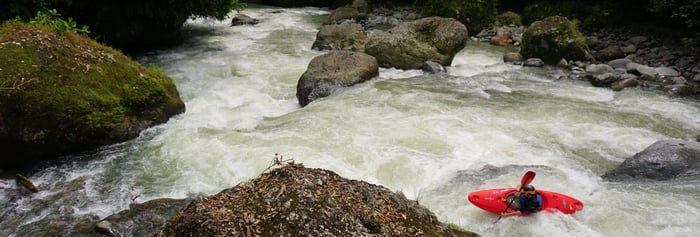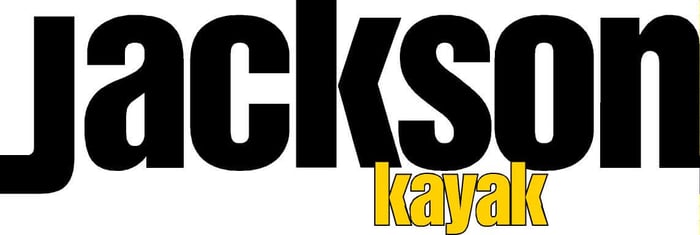There are so many different brands, shapes and styles of whitewater kayak paddles that it is often hard to figure out what is right for you. Below we have compiled some information to help you navigate the shaft options, materials, sizing and blade shape to try and find what will work best for you.
SHAFT OPTIONS
1. Straight Shaft: As the name suggests, these paddles have a straight shaft, which is more cost effective and lighter than other options. It will have a familiar feel as most paddlers no matter how new to the sport start out with straight shaft paddles.

2. Bent Shaft: Designed with body ergonomics in mind, bent shaft paddles allow your wrists to sit in a more natural position which prevents over stressing the small tendons and ligaments in that area. A great choice for those who have some existing aches and pains in the elbow/wrist region or for those who paddle for extended periods of time. More expensive and a little heavier that straight shaft paddles but the extra expense is worth it in a lot of cases to be able to paddle pain free.

3. Shaft Diameter: Most paddles now come with varying shaft sizes, usually small and regular. If you are a small person with small hands then a small shaft paddle will help prevent extra fatigue associated with trying to hold on to a large paddle shaft for long periods of time. Those with average to larger hands will be generally best served by a regular diameter paddle shaft.
MATERIALS
When choosing a whitewater kayaking paddle you need to find something that works for you and is within your budget. The material you select for your paddle will influence performance and price a great deal.
1. Carbon is typically the lightest, stiffest, most powerful, and most expensive paddle option. It has very little flex, which translates to no loss of power on each stroke. It also takes the longest to wear down.

2. Fiberglass is like carbons overachieving younger sibling – strong, lightweight, less expensive than carbon, and has a little more flex. This can be good on sensitive wrists and joints though does sacrifice some power in your stroke.

3. ABS/Nylon is often referred to as 'plastic' paddle. This is a bit misleading as some of the good quality nylon/ABS paddles out there really perform well and hold up to a bunch of abuse. Often reinforced with glass or carbon, these paddles are a great cost effective option for paddlers on a tighter budget.

BLADE SIZE
What you are paddling, how often you are paddling, and physical conditioning will determine what size blade would best suit you. Most manufacturers offer paddles with smaller and larger blade sizes. A larger blade is best suited for stronger, better conditioned kayakers wanting maximum acceleration and power. Smaller paddlers may prefer the reduced volume of smaller blades as it allows power to be generated from a faster paddle cadence rather than power and strength alone.
BLADE SHAPES
When selecting the paddle blade shape, try and apply the 80/20 rule and make the selection based on what you think you will be doing 80% of the time. All the blade shapes are capable in a variety of paddling settings so it’s best to choose a paddle based on what you will be doing most of the time.
1. River Running / Creeking: If you are primarily going to be going downstream, running rapids, working on skills or running waterfalls and harder rapids, a blade shape that maximizes the efficiency of your forward stroke is your best asset. This will help you avoid holes, waves, rocks and other features on the river. River running blades have volume built into the tip and bottom of the blade for maximum efficiency in the catch and power phases of the paddle stroke. The Werner Sherpa and Werner Powerhouse are examples of this.

2. Playboating / Freestyle: If you are looking to do more playboating than river running you might find the traditional river running blades have volume in the wrong place(s). This often translates to hitting the boat regularly when initiating or performing moves. Playboat blades have volume cut away near the join with the shaft which prevents 'catching' the blade on the edge of the boat. The Werner Player and Werner Sidekick are examples of freestyle paddles.
LENGTHS
The last thing we are going to look at is the correct length of a paddle. This does vary but we are providing some general guidelines below. Again, think about what you are going to be doing most of the time.
1. River Running / Creeking Paddles: These tend to be longer as you want to increase the effective 'catch' of the paddle (this simply means that your paddle will enter the water sooner, facilitating a more powerful and effective stroke). A general rule is 194cm is suitable for shorter paddlers, 197cm for average height paddlers, and 200 for taller paddlers.
2. Playboating/Freestyle Paddles: As there is a greater need for dynamic paddle movements and fast movements, playboating paddles tend to be shorter in length. This also somewhat reduces the risk of shoulder injuries with too much torque on the blade from a longer paddle. A rule of thumb for freestyle paddles is 191cm for shorter paddlers, 194cm for average sized paddlers and 197 for larger paddlers.
These are just guidelines and chatting with a paddlesports expert will help you get a more solid idea of what exactly you need. CLICK HERE to view our whitewater paddles. We hope this information was useful and if you need any clarification or further information please don't hesitate to contact us.
























































